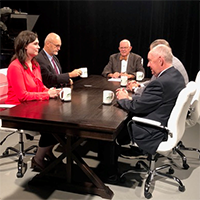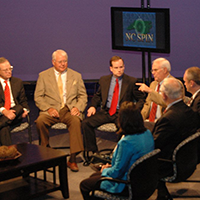Growing old isn't for Ostriches
Published June 19, 2025
By Tom Campbell
A somewhat older friend and I were driving home from a restaurant and as we passed a senior living facility, he remarked that he and his wife had put their names on a waiting list at that place and one other.
“Out of curiosity,” I asked, “how much does it cost to live there?”
He said the facility we just passed cost around $8,000 per month for the two of them to live in a two-bedroom apartment in independent living, adding quickly that prices would be a little lower for just one person or if the apartment was only a one-bedroom or studio apartment. And he also reminded me this was independent living. Assisted living or memory care living costs more.
Next year, the oldest of the baby boomers turns 80. Most never thought much about growing old or what they might face when they do. There are at least two questions they should be asking: Where am I going to live in old age and what if I can’t totally care for myself?
Remember the TV show, The Waltons? Three generations lived in the same house. Those days are long gone. As life expectancy has increased, we’ve witnessed an explosion in senior care facilities. But they call them the “golden years” because it takes a lot of gold to live.
The Division of Aging and Adult Services in North Carolina reports that in 2020, one in every six persons was over 65. By 2028, it is projected to be one in five. By 2031, there will be more North Carolinians over 65 than children under 18. By 2040, 90 of our 100 counties will have more people over 60 than those under 17. The population over 85 will have the fastest percentage growth and they are migrating to metropolitan areas. They will require more services.
The Social Security Administration projects that if you live to age 70, 30 percent of men and 42 percent of women will live to 90. Kiplinger says the median net worth of a 70-year-old is $367,286. Assuming you could find acceptable senior living at $5,000 per month, fewer than half of us could pay $60,000 a year for more than a handful of years.
Most seniors pooh-pooh the idea, saying they want to age in place, where they live now. They won’t accept that functional limitations, frailty and chronic diseases might prevent that from happening.
KFF, the independent source for health policy research, polling and news published findings that only 43 percent of adults have ever had a serious conversation with a loved one about who will take care of them if they need help with daily activities or how the costs will be paid. Only 28 percent of those under 65 say they have set aside money to pay for future living assistance. 48 percent of those over 65 acknowledge some savings for these purposes. The overwhelming majority admit it would be impossible for them to pay the estimated $100,000 a year for a year at a nursing home or even the $60,000 a year for a skilled nurse.
KFF reported there is widespread confusion over who will provide long-term care should they need it. Medicaid is the primary source for these services and there are income restrictions for qualifying for that care. Medicare is limited in providing long-term care, leaving many finding it difficult to find long-term care and support services they can afford. Without long-term healthcare insurance the costs are prohibitive, often impacting close family members.
We’ve all heard that getting old isn’t for sissies. Neither is it for ostriches. If we are fortunate enough to live into our 70s, 80s or even 90s there will be challenges from which we cannot hide.
Here are a few suggestions. Give some serious thought to how you want to live your later life. Will you be able to stay in your own home? What help will you need and who will provide it?
Have a meeting with your family and/or caregivers on whom you can depend. Tell them your plan and ask their input. What have you forgotten? What have you over or underestimated? Consider purchasing Long Term Health Insurance. It is expensive and the later you wait the more the annual premiums will be, but it might stave off big future financial problems.
Finally, it is imperative that you have a will, providing instructions for those you leave behind. Put your plans in writing and make sure family and/or potential caregivers know where they are located.
Those of us who are aging can testify things don’t work as well as they once did. Our balance, strength and overall health are constant reminders of that truth. But these can be golden years if we face the truth and plan as best we can for what lies ahead.
Don’t be an Ostrich!
Tom Campbell is a Hall of Fame North Carolina broadcaster and columnist who has covered North Carolina public policy issues since 1965. Contact him at tomcamp@carolinabroadcasting.com







